October 27, 2019 📊The puzzle of Joe Biden’s lead
Plus, partisanship and impeachment polling; the numbers behind Warren’s rise; and a history of American lynching
Welcome! I’m G. Elliott Morris, data journalist for The Economist and blogger of polls, elections, and political science. Happy Sunday! This is my weekly email where I write about politics using data and share links to what I’ve been reading and writing. Thoughts? Drop me a line (or just respond to this email). Like what you’re reading? Tap the ❤️ below the title and share with your friends!
Dear Reader,
This week’s main read: Some people are writing about Joe Biden’s waning prospects in the Democratic primary. The thing is, Biden’s position hasn’t changed much—nationally. But in key states he is struggling as other candidate surge. I dive in to Biden’s relative weakness in key states and with key demographics.
Plus, I’ve got links to my work on Elizabeth Warren’s rise and how partisanship shapes impeachment polling, work from the Pew Research Center on how to interpret polling and data on lynching.
Thanks all for reading my weekly email. Please consider sharing online and/or forwarding to a friend. The more readers, the merrier! If you’re shy, the best way you can support my newsletter is to press the heart button below the title (this makes it rank higher in Substack’s curation). If you’d like to read more of my blogging I publish subscriber-only content 1-3x a week on this platform. Click the button below to learn more!
—Elliott
PS! I’m giving away free trials to the paid content in my newsletter from now until November 1st. I’d love if you shared it with your friends. Click the button below or follow this link: https://thecrosstab.substack.com/subfriends
This Week's Main Read
The puzzle of Joe Biden’s lead
The former vice-president is relying on big wins in the south to offset early losses in whiter states. But can he last that long?
Joe Biden is in roughly the same position in national political polls as he has been for the past 3 months of the 2020 Democratic primary. According to The Economist’s polling aggregate, 25% of voters support Biden today, versus 27% in early August.
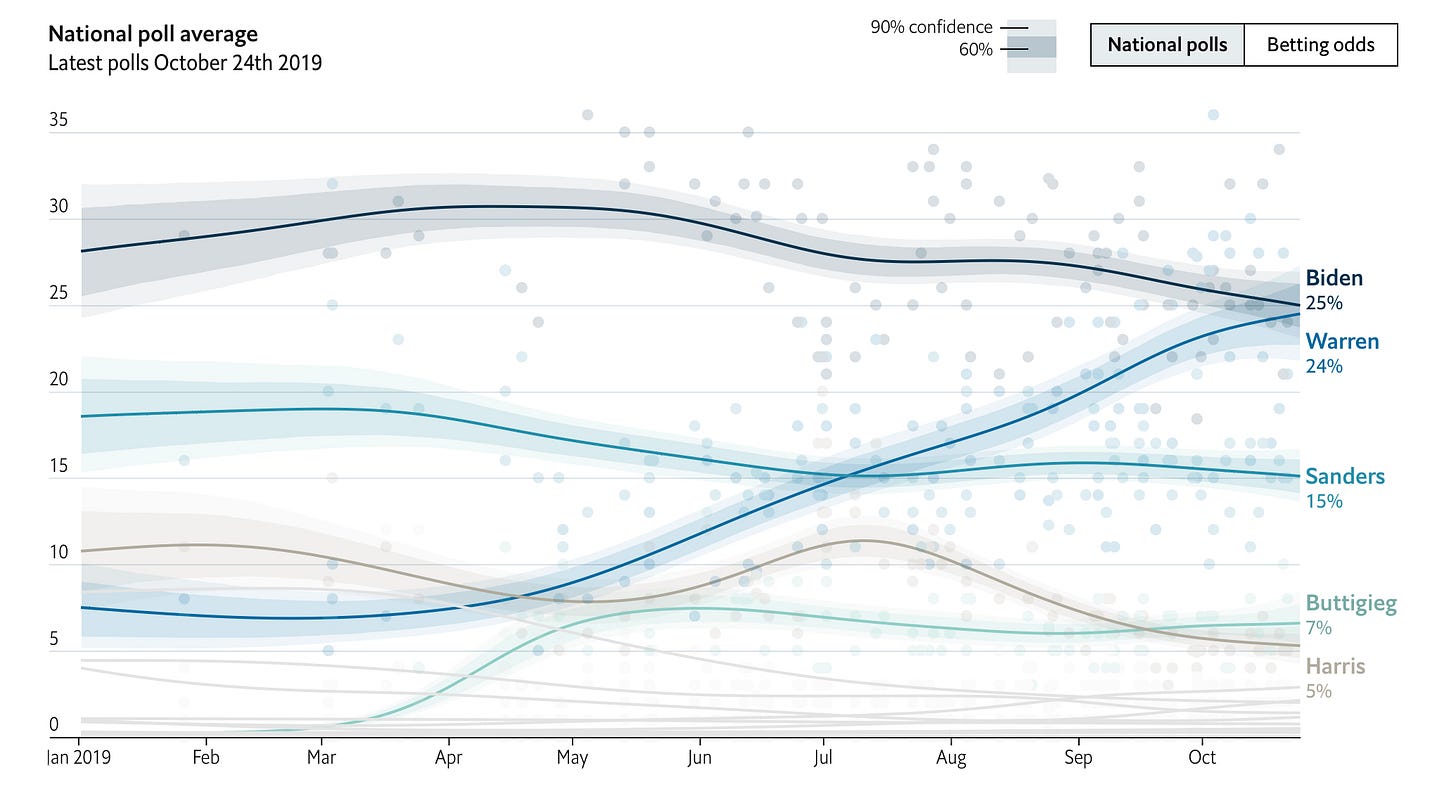
That Joe Biden has a relatively steady base of 25-30% of Democrats nationally has spawned some contrarian takes about his strength. Whereas Olivia Nuzzi writes for New York Magazine today that it looks “unmistakably” like the nomination is going to “slip through [Joe Biden’s] fingers” again, Nate Silver has said that there “hasn’t been much sign of a decline in Biden’s numbers”. Nuzzi points out that Biden’s polling lead has fallen from a high point of 33% in the RealClearPolitics average in May to 5.4% now, and Silver implies both RCP’s average is too noisy and that Biden is up 0.6 percentage points since his average of polls taken before September 23rd. So which one is it? Is Biden in trouble or doing fine?
This hemming and hawing over national polling obscures Joe Biden’s real vulnerability: his standing in the early states. Although the vice-president is leading handily in South Carolina—the RealClearPolitics average has him up twenty points over his nearest competitor, Elizabeth Warren—Biden is currently polling below Warren in Iowa and New Hampshire and up just 4 points in Nevada. The Super Tuesday states such as California, Texas and Massachusetts are also a mixed bag for the VP.
The big question for Biden is whether he can survive the media/reputational/electability blows he’ll suffer from losses in Iowa and New Hampshire. I’m unsure about his chances of doing so. In 2008, Hillary Clinton could not pull off a similar strategy, largely because black voters—who had favored her 60-30 for the nomination in December—flipped to supporting Barack Obama—by a 55-40 margin—by February. And if he fails in early states, voters may never come back to the idea that he’s the default choice. In 2016, Bernie Sanders’s insurgent victory in New Hampshire suggested that someone other than Clinton could win the nomination, giving way to a primary challenge that would last until the convention.
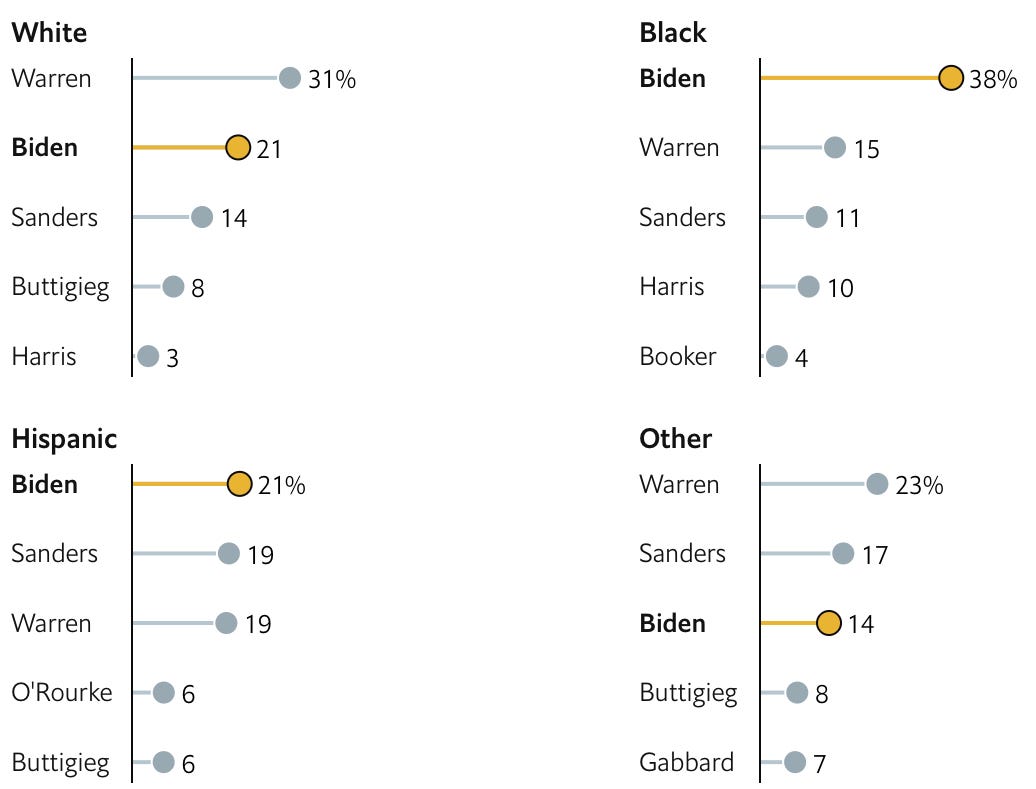
Joe Biden also has a connected demographics puzzle to sort out. Although his strength with non-whites presents a cushion if he loses Iowa and New Hampshire, their disproportionate numbers in southern states presents a big problem if he starts losing ground among them. And white voters haven’t shown a willingness to bail him out; they currently favor Warren over Biden 31 to 21 percent.
Maybe we can put it this way: Joe Biden has been treading water in the 2020 primary since he entered. Do we think that treading water is enough to win?
And here are some selected links to the work I read and wrote last week:
Posts for subscribers:
October 24, 2019: A brewing 2020 Democratic revolt? Supporters of fringe Democrats, and Bernie Sanders, voice likelihood of disloyalty in 2020.
Political Data
From me for The Economist: “How being second choice could put Elizabeth Warren on top”
Ms Warren generates enthusiasm among her followers. But her popularity among supporters of her rivals in the Democratic field is even more impressive. A large proportion of Democrats who favour the other leading contenders would consider voting for Ms Warren, including 41% of Mr Biden’s supporters and 40% of Mr Sanders’ boosters. A whopping 52% of those who favour Pete Buttigieg, the mayor of South Bend, Indiana, would consider Ms Warren, too. Among the leading candidates, only supporters of Andrew Yang, an entrepreneur from New York, do not rank Ms Warren as their second choice.
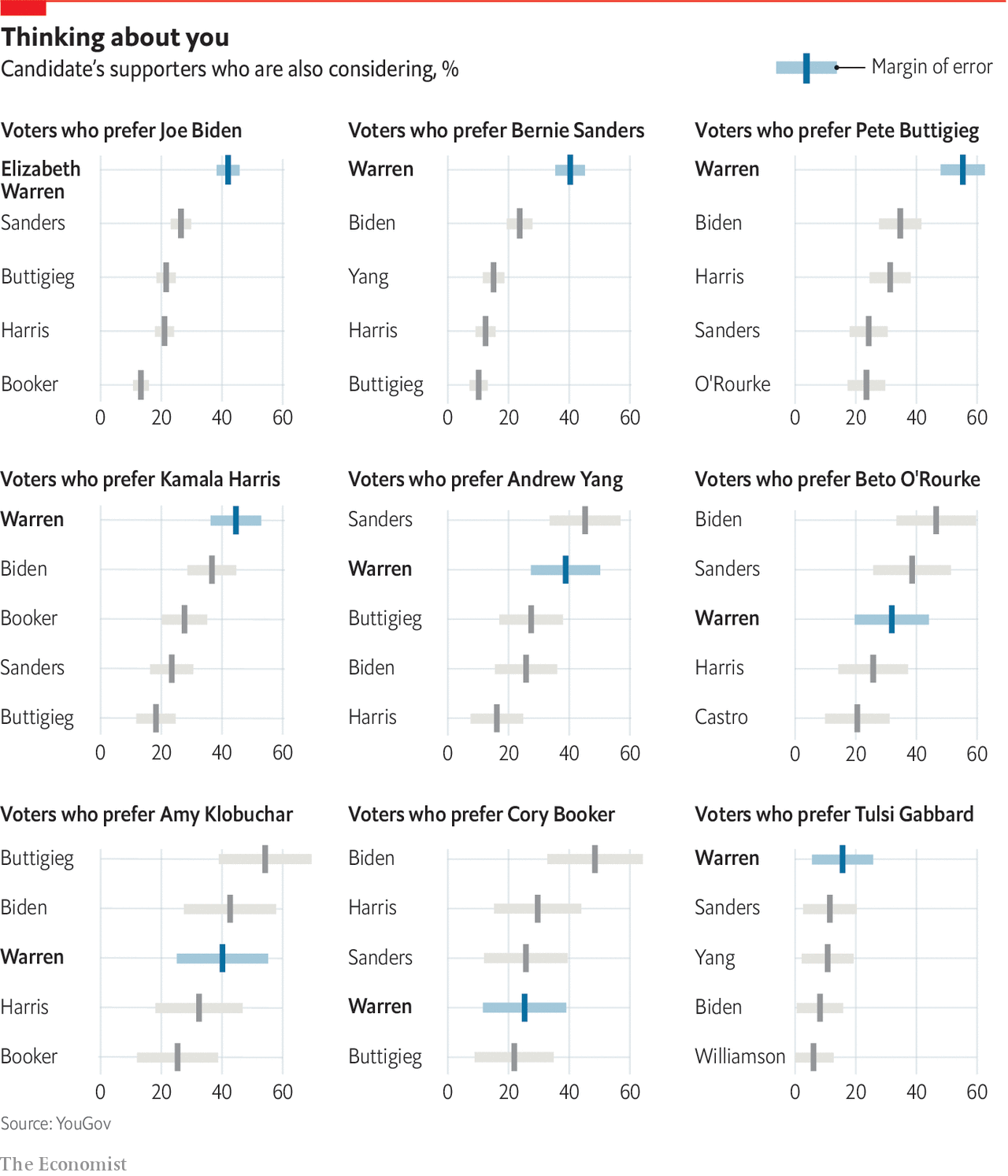
Also from me for The Economist: “Americans’ views on impeachment mirror the president’s approval ratings”
The Economist’s analysis of political polls reveals that in early September, before news broke that Mr Trump had asked President Volodymyr Zelensky of Ukraine to investigate a political rival in return for military aid, roughly 45% of Americans opposed impeaching Mr Trump and 42% approved of his job as president. That gap closed the following month when Democrats announced they would begin an impeachment inquiry. On October 23rd, 41 % of Americans approved of Mr Trump’s job performance and the same share opposed impeaching him. The share of those Americans who wanted to impeach him grew. In September, 54% of adults disapproved of Mr Trump and 45% supported impeaching him. By late October, the president’s disapproval rating was the same but 50% wanted him out of office.
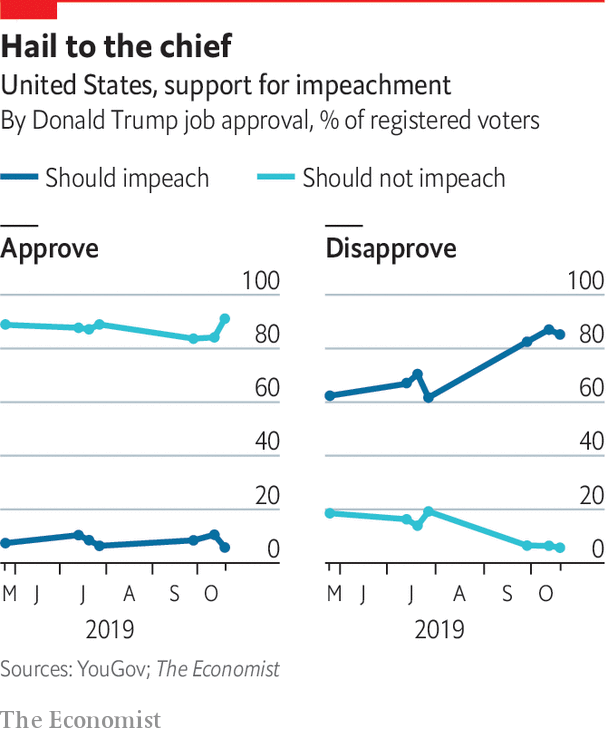
Nate Cohn (The Upshot): “What Our Poll Shows About Impeachment Views in 6 Swing States”
In the six closest states carried by the president in 2016, registered voters support the impeachment inquiry by a five-point margin, 50 percent to 45 percent. The same voters oppose impeaching Mr. Trump and removing him from office, 53 percent to 43 percent.
The survey depicts a deeply divided electorate in battleground states a year from the election, with the president’s core supporters and opponents exceptionally energized and unified. Yet at the same time, a crucial sliver of relatively moderate voters — just 7 percent of the electorate — support the inquiry without backing Mr. Trump’s impeachment and removal from office.
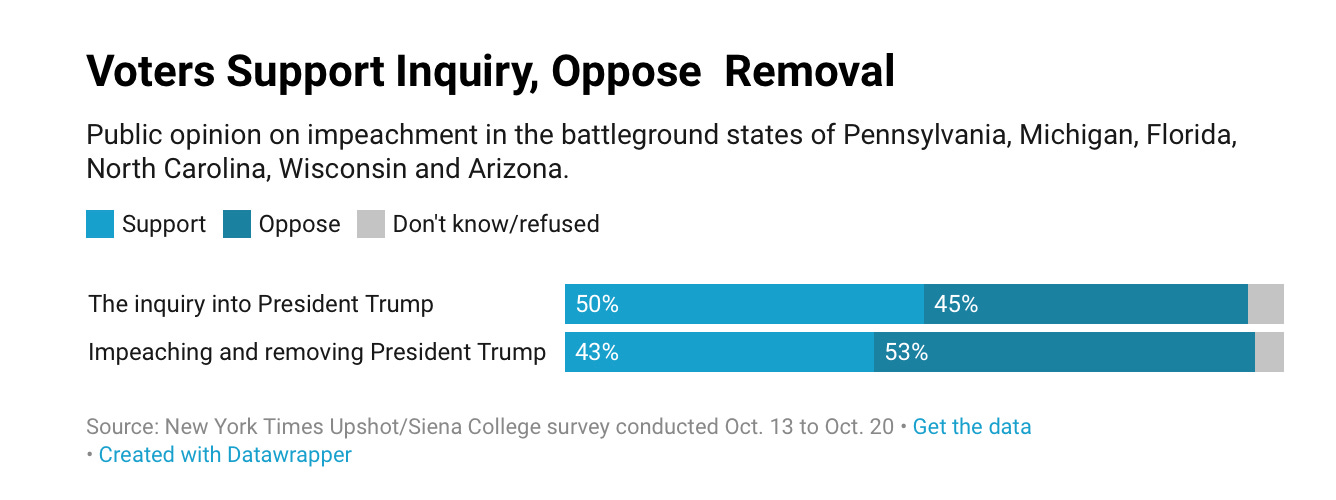
Kabir Khanna (CBS News): “Analysis: Which voters are changing their minds in fluid Democratic primary race”
About two in ten of Warren's July supporters changed their minds at some point (the lowest rate for any of the leading candidates). While 13% of her July supporters switched away from her and stuck with different candidates, 7% of them ended up switching back to her in October. So her net loss between July and October was really just 13%.
Sanders and Biden have lost a respective 18% of 23% of their July supporters, but Biden had more switch back to him in October, mitigating his losses (7% vs. 3% for Sanders). A sizeable 35% of Buttigieg's July supporters switched away from him, but another 11% switched back.
Harris has lost the biggest chunk of her July supporters: 65% switched away, while only 7% switched back to her. These voters changing their minds have driven her decline in the polls since the summer, with the plurality of them now backing Warren.
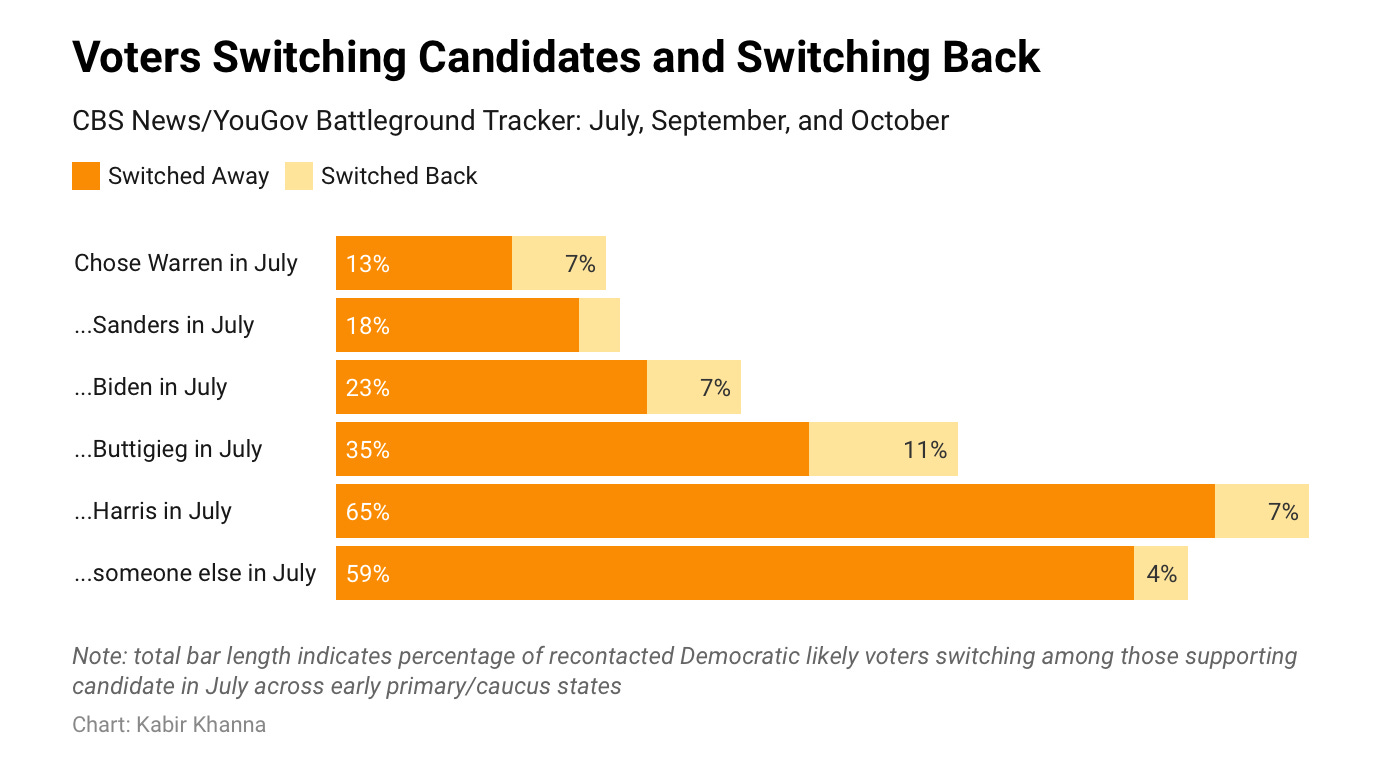
John Gramlich (Pew Research Center): “5 tips for writing about polls”
Always be clear about who was surveyed
Let your readers know when the survey was conducted
Stay faithful to the way survey questions were worded
Pay attention to margins of error
It’s good to provide context, but it’s dangerous to ascribe causality
Other Data
Danny Lewis (National Geographic): “This Map Shows Over a Century of Documented Lynchings in the United States”
It’s unlikely historians will ever know just how many lynchings happened throughout the history of the U.S., as many likely went unreported, or were not classified as lynchings in documentation at the time. However, the sheer number of those that are on the books is staggering—according to the Equal Justice Initiative’s (EJI) 2015 report, Lynching in America, more than 4,000 black people were publicly murdered in the U.S. between 1877 and 1950. Tools like this site serves as an important endeavor to help mark these dark parts of American history and make it more visible and accessible for all.
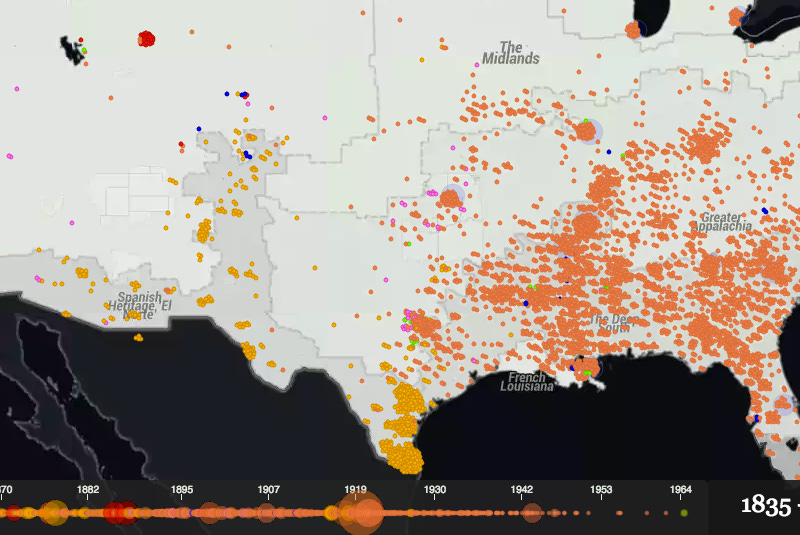
Political Science, Survey Research, and Other Nerdy Things
Not exactly a research paper or even explicitly scientific, but this newsletter from the NYT on how social media is making protests more common while polarization weakens their effects is spot-on.
What I'm Reading and Working On
This week I’ll have some exciting and innovative work on Chinese Twitter bot networks and the NBA. I’m also working out some math on impeachment and the Senate. Stay tuned. I’m reading a lot of books right now, but the one I’m particularly enjoying is a collection of short stories from Hemingway titled “In Our Time”.
Something Fun
I am not a huge football fan, but I do enjoy data and Texas, so this piece from FiveThirtyEight was fun and revealing. “How Widespread if Your College Football Fan Base?”
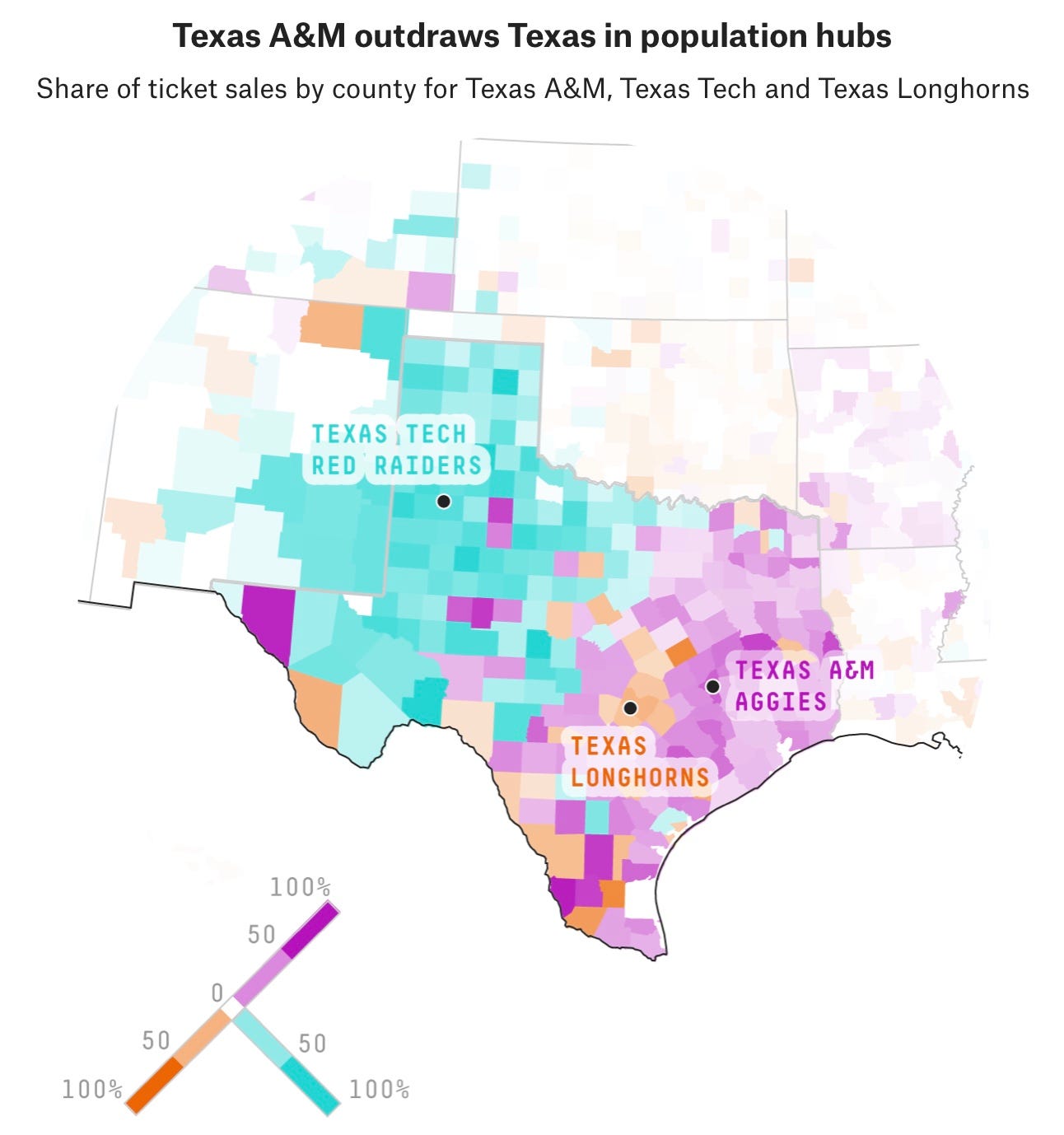
Thanks for reading!
Thanks for reading. I’ll be back in your inbox next Sunday. In the meantime, follow me online or reach out via email. I’d love to hear from you!
If you want more content, I publish subscribers-only posts on Substack 1-3 times each week. Sign up today for $5/month (or $50/year) by clicking on the following button. Even if you don't want the extra posts, the funds go toward supporting the time spent writing this free, weekly letter. Your support makes this all possible!



